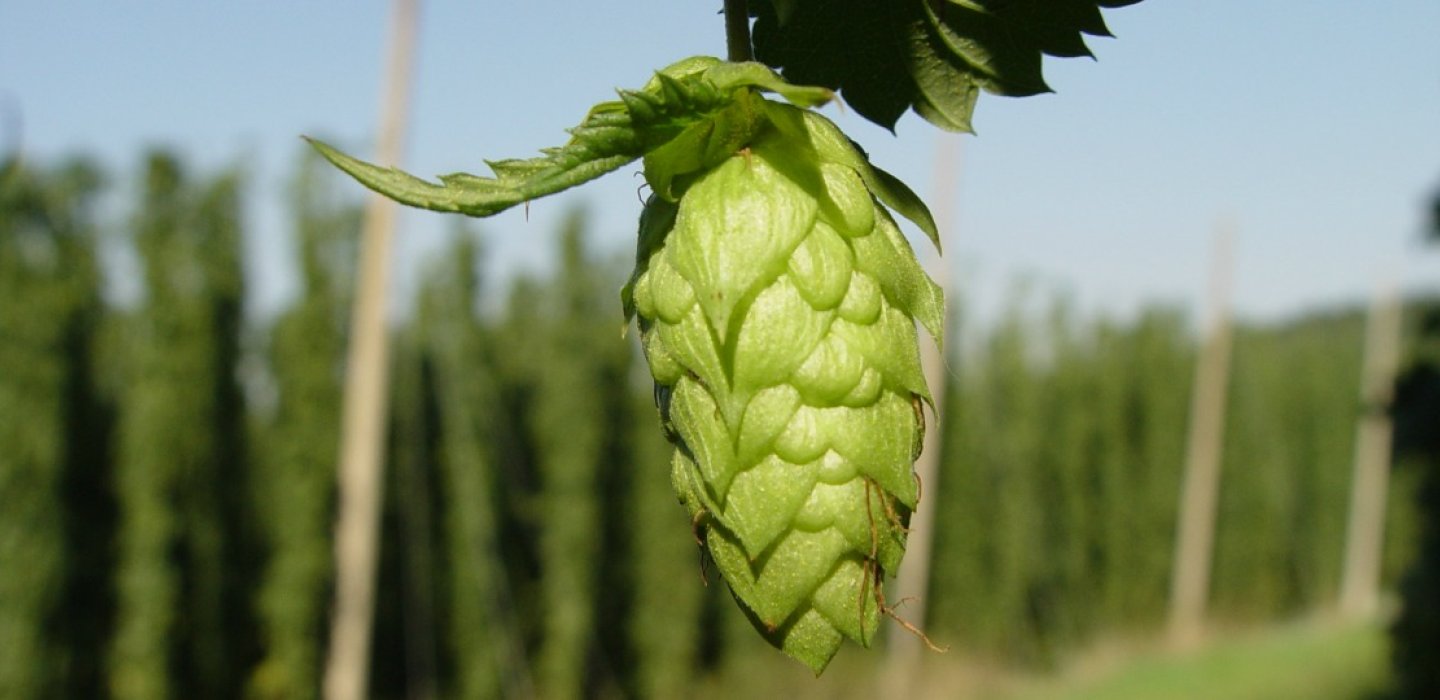
In 1880, Franklin County produced over 1 million pounds of hops. The main use for hops is the brewing of beer.
Now that I have your attention, there's more good news.
After that heady time (a couple of decades before and after the turn of the 20th Century) North Country hop growing went into a steep decline. Today, the Cornell Cooperative Extension of Franklin County is seeking to change that. They want to support local craft breweries with supplies of the fine hops which were once a staple crop in this area.
hop heyday
Hops are a member of the hemp family. They grow on climbing vines, and need support. There was once a thriving industry in hop poles, made from cedar, or the cheaper but less durable, spruce. Letting the vines grow upwards meant more yield per acre, and more air circulation through the plants. Mildew is the greatest threat to hops.
Providing support for the vines also encourages the plant to put their energy into the valuable flower heads, or seed cones, instead of structural cell growth to support the plant. It is the the heads, plucked in late summer before they flower, which become the crop known as hops.

There were many factors contributing to the appeal of hops to local farmers. The soil that is good for potatoes is also good for hops. The harvesting for hops was less labor intensive than digging up potatoes, and did not require any special expertise. Older children, women, and men of all ages could move through the rows and earn money.
It took long hours in the hop kiln to dry out the flowerheads, and then, a month later, the pressing into bales would complete the process. Brimstone, as a source of sulphur, would be dusted on the leaves as a fine powder (known as Flowers of Sulphur) to combat mildew, and would also be laid on the drying fires. This sped up the process of drying, but also created hops with brighter color and better flavor.
Small growers, of under an acre, would put the dried flower heads into burlap bags, like potatoes. The resulting product kept well, even making it overseas to supply the German beer market, as well as those closer to home.

Hops were considered a good cash crop, even after paying the pickers the standard sum of a dollar per day. Franklin County produced its record crop in 1887, estimated at over 17,000 bales. Hops were looked at as the road to riches, a crop which would keep on being lucrative.
So lucrative it became something of a speculative mania.
Road to ruin
Hops had become a mainstay of the local economy. They required more of an investment in fertilizer (at that time, manure) and took two years to start producing, along with the labor of training the vines and hoeing out the weeds. Kiln houses and supplies were another expense. Only the fine price hops fetched on the market supported the extra effort.

The situation attracted the attention of Robert Schroeder, a man known for his large red beard and his equally outsized zest for life. The son of a wealthy German brewer, he traveled all over the area on hop buying trips. On one of these expeditions to Franklin County he encountered Debar Pond, in Duane, NY. And fell in love.
He was certain that he could build his own paradise by growing hops in this gorgeous area. In 1883 he purchased 2,100 acres, which included abundant forest and 300 acres in farmland, almost all of the arable land in town. Intent on his dream, he did not ask why the owners were so eager to sell out, and accepted inflated prices for land which turned out to need more fertilizer than the richer lands to the north.

He was intent on creating the largest hop farm in the world.
He was known for the lavishness of his mansion and the largeness of his hop houses. Early on, Mr. Schroeder was a bachelor, and the summer months at his place were also known for the "fast and loud" times had by his male guests from New York City. Much wine went in, and much broken crockery went out.
This first structure burned down in early 1885, and so he created a castle made of stone for his personal home. Here he brought his bride, the daughter of the owner of the Ullman breweries. There were more than sixty rooms, with solid mahogany staircases, a dining room paneled in rare wood, a library, conservatory, billiard room, library, and a ball room. The entrance hall had four large stained-glass windows, imported from Germany, and fine furniture shipped from Holland.

With two fortunes to draw upon, Mr. and Mrs. Schroeder enjoyed themselves as befitted folks who lived in a castle. They had a stable of thoroughbreds for their private half-mile racetrack. His servants kept a tub of ice at his foot, so his champagne was always properly chilled.
All, still, might have been well, had his hop farm developed the way he had envisioned. But hops' peak was sadly over. A crop which had once been worth a dollar a pound plunged to eighteen cents per pound.
By 1902 Schroeder filed for bankruptcy.

Worse was yet to come for the hop industry, as wet weather patterns created a serious mildew problem, and hops were particularly vulnerable to this ailment. In 1909 there was an outbreak of downy mildew (sphaerotheca humuli) that stubbornly resisted all efforts to contain it, and in 1914, an infestation of hop aphids took down acres of crops before they could be harvested.
Then, the true killing blow: Prohibition. There were just too many hurdles to clear on the way to a profitable hops season.
"When Prohibition was imposed in the United States at the end of World War I, hop growing in New York was abandoned for good."
---Shaun Townsend, The Oxford Companion To Beer
hops make a comeback
But now, more than a century later, the prospects are starting to shine again. In 2012, craft breweries gained the ability to sell beer by the glass, as long as a certain percentage of the ingredients would come from New York State. This proportion started at twenty percent, will rise to sixty percent in 2019, and will be ninety percent in 2024.
That sounds like a market.
Accordingly, the state hop acreage has jumped from a measly 15 acres to 250 acres, and that acreage is growing all the time. It is the popularity of microbreweries, and now, farm breweries, which will bring back the hop crop. The Cornell Cooperative Extension of Franklin County is holding seminars and compiling educational materials to help growers.
Fans of beer can rejoice.
Pick some fun lodging. Look for local beers at one of our dining establishments. Find out more about Malone's history at the House of History, the Franklin County Historical Museum.
Header photo courtesy of Wikipedia. Modern hop photos from the Cornell Cooperative of Franklin County. Historic photos and history from reynoldstonnewyork.org.
Adk heritage - the backstory:






Comments
Add new comment